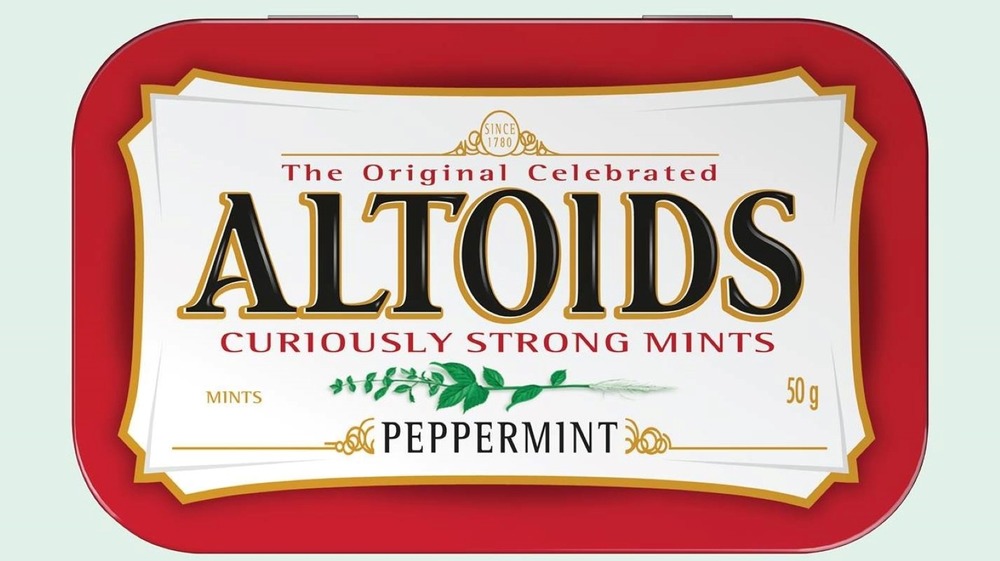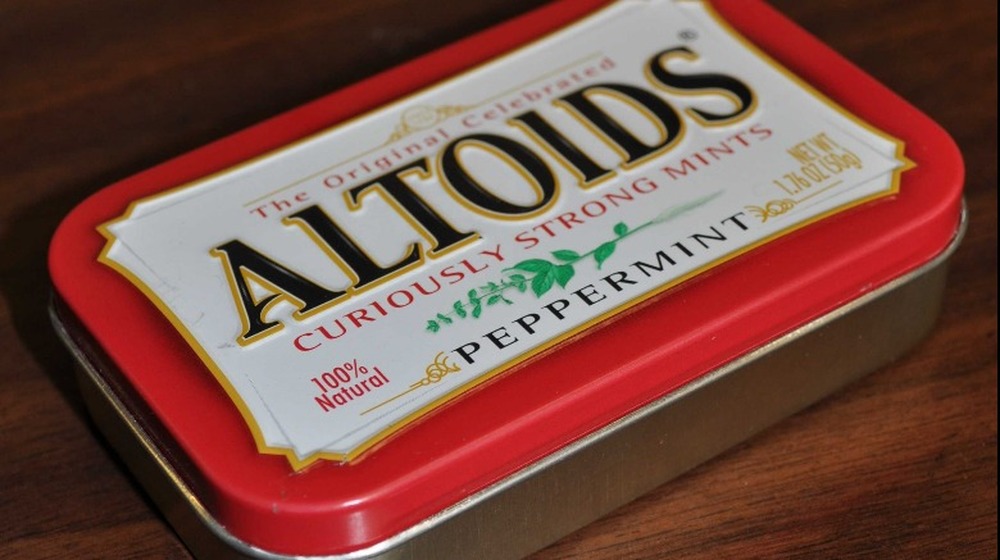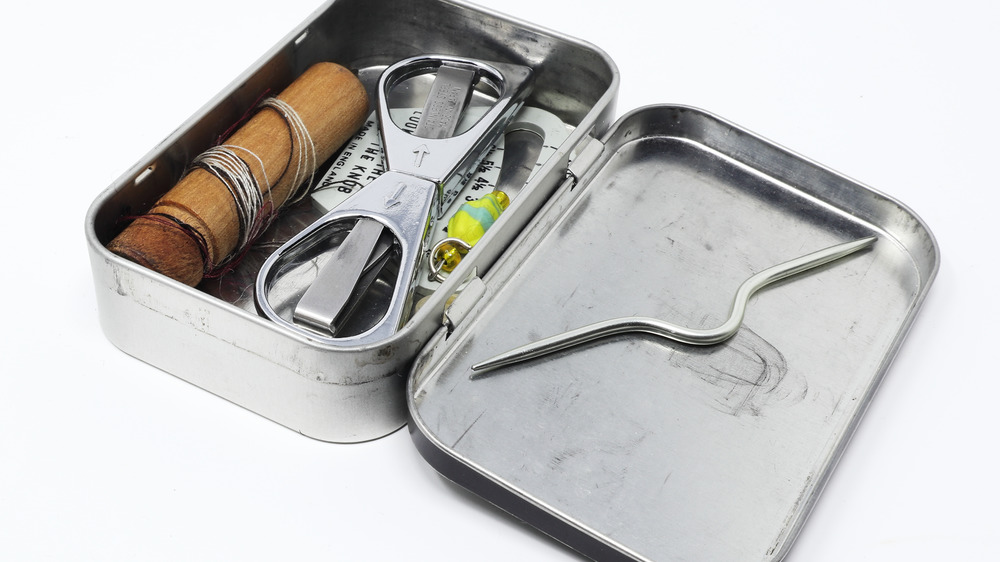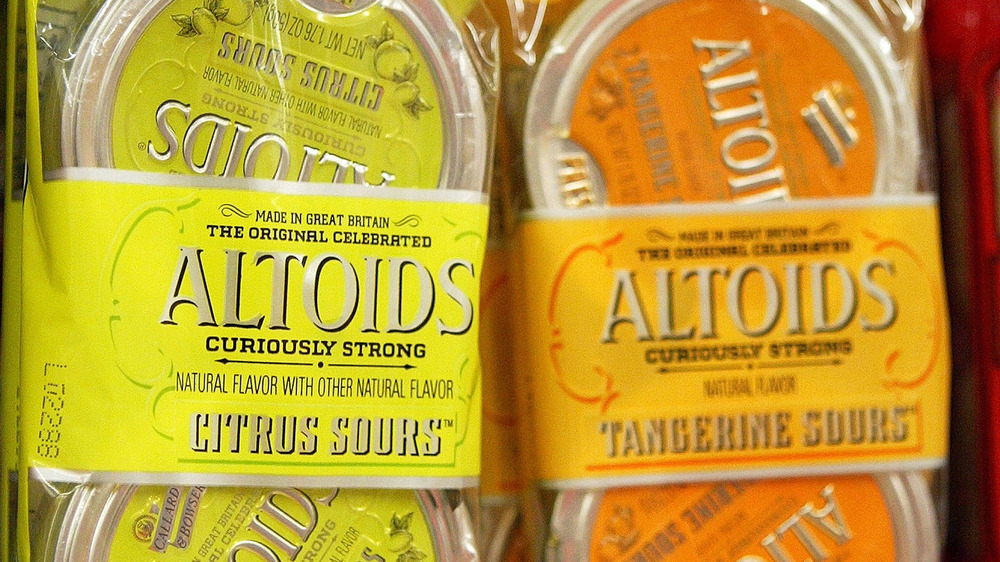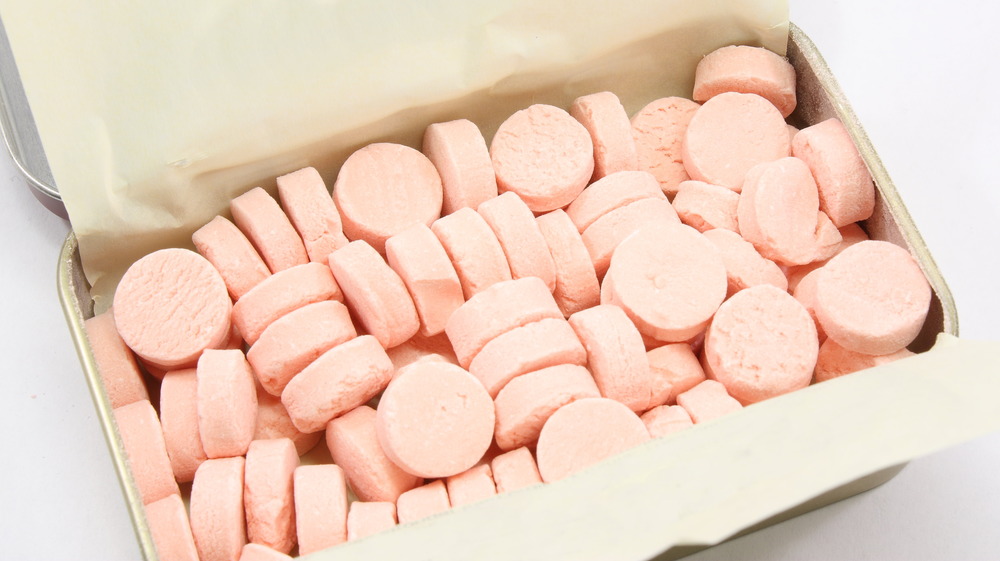What You Didn't Know About Altoids
We may receive a commission on purchases made from links.
While popular in the U.S. since the early '90s, Altoids have actually been manufactured for over 240 years! Created in London in the 1780s, they weren't originally invented with bad breath in mind. According to the Mars website, their original purpose was to help calm upset stomachs, and The LA Times adds that Altoids were also meant to alleviate gas-related distress. In addition, advertisements of the time suggested that "one or two taken after meals will stop any poisonous fermentation" (via The Orlando Sentinel). What that means in modern terms is open to interpretation, but the ominous-sounding verbiage does seem to describe something you would want to prevent.
The name Altoids has its origins in Greek, breaking down into "alt" (meaning "to change") and "oids" (meaning to take the form of something). Because they were originally intended as an aid for stomach issues, the name may have been meant to indicate that the mints would change, ie. take away, that stomach discomfort. Along with the promoted digestive benefits, in the 1930s, they were curiously marketed to the dieters as "a splendid remedy against the distressing effects of fasting too long."
Altoids started slowly changing the marketing towards being a cure for bad breath sometime after World War II, notes The Wall Street Journal, but it wasn't until coffee drinks exploded in popularity that they really took off. And as of 2020, Statista reports, Altoids are now the top-selling breath mint in America, narrowly beating out its closest competitor, Tic Tacs.
It took decades for Altoids to become extremely popular in the U.S.
First introduced in the United States in 1918 (via LeafTV), Altoids didn't race up the popularity scale until late in the 20th century. In The Wall Street Journal's reporting on Altoids' incredible growth, they note that the mints' popularity boomed in the United States in the early '90s. That exponential increase in sales was thanks primarily to an ad campaign targeted at coffee drinkers who used the mints to temper their post-espresso breath. The ads featured the now well-known, witty slogans, including, "Not recommended for the faint of tongue" and "Mints so strong, they come in a metal box."
Then came the celebrity fans, including Joan Rivers and talk show host Rosie O'Donnell, who supposedly ate them before every show, and those endorsements caused Altoids' sales to skyrocket (via The L.A. Times). In 1998, marketing expert Mark Sugden told CNN Money, "What I can say is over the last five or six years Altoids sales have increased on average by 40 percent year-on-year."
It's all about the metal box.
When Altoids came to the States in 1918, they originally were sold in a cardboard box. It wasn't until the early 1920s that they swapped to using the red metal tin that's so well known today, reports LeafTV. Those tins gained a fandom of their own.
In the '80s, the company noticed that actually a lot of people were eating the mints and then keeping the tins (via The Wall Street Journal). The New York Times devoted an entire article to different, practical ways people have reused them, including building an MP3 player. An article by Art of Manliness showed creative, clever, unexpected ways to reuse the metal tins, including using them for sewing kits and mini flashlights. Handcrafted By Stephanie used them to make a DIY advent calendar, while the Ham Radio Crash Course channel even posted a YouTube video showing how to build a "QRP CW Morse Code amount radio kit" out of an Altoids box. It makes sense. In 2005, a marketing director for Altoids' manufacturer explained, "Altoids tins were originally used for shortwave radios."
Because the mints are kept securely in the tin, people can also feel more comfortable sharing them. Back in 1998, Amoco attorney Bob Stout explained, "[With] a roll of mints, [people] feel kind of funny peeling off the paper and they don't know where it's been. You can keep them in the box and people feel very comfortable taking one" (via CNN Money).
Altoids products also had some misses
While people might associate Altoids with the classic red box of peppermint lozenges, there are actually multiple flavors, such as wintergreen, spearmint, and cinnamon. As a brand, they also make sugar-free Altoids Smalls, made with sorbitol and sucralose instead of sugar (via Amazon).
Some other Altoids products did not do as well as the classic mints. In the early 2000s, the company produced Altoids Sours, Altoids Gum, and Altoids Breath Strips, none of which proved popular enough to last. The Candy Encyclopedia by Fandom reports the gum was discontinued somewhere around 2010. The claim appears to be corroborated by Amazon reviews, with commenters lamenting in 2010 and later about the discontinuation of the gum. Kiddle reports that the breath strips stopped production in 2007, and product listings on Amazon note they have been discontinued. Altoids Sours were pulled in 2010 "due to low national demand," according to a Wrigley statement cited by Bustle
However, the sours have a cult following. Fans buy them on eBay, and the demand is apparently so great that unopened tins of Altoids Sours have sold for upwards of $100, with even empty tins selling for $12-$25. Altoids social media pages receive comments asking for Altoids to bring back the sours. As Facebook user Robbie Harris notes, "Unbelievable, Altoids can't make a single post without at least 3 people bringing up sours. Also, bring back sours." There's a Facebook group devoted solely to bringing them back, and one determined fan even started a Change.org petition in 2013 for their return, though it only received 174 signatures.
Surprisingly, there are some downsides to Altoids.
A weird side effect of eating Altoids is that in some people, the strong mint flavor can trigger sneezing fits, Wales Online reports. Called a photic sneeze reflex — cutely named the "ACHOO" syndrome — it's an inherited trait and can be also triggered by changes in bright light or from eating spicy food, according to Healthline.
Eating too many sugary mints, such as non-sugar-free Altoids, can actually give you bad breath in the long run. According to a report by Yahoo! News, the sugar can build up in your mouth, creating a perfect breeding ground for the bacteria that cause your bad breath, to begin with. The freshness is also often temporary. Dentists at Carefree Dental note that since Altoids now are primarily made with sugar and artificial flavors, there's nothing like peppermint oil or other natural ingredients that would stick around and keep your mouth fresh.
Altoids infiltrated Hollywood....and the headlines.
It wasn't just the big stars that loved Altoids. The mints, and the tins, continued to show up everywhere well into the 21st century, including appearances on a number of TV shows and films. In the TV show Columbo, the title character stores his small cigars in an Altoid tin (via IMDb). In the "Pavlov Experiment" episode of The Office, the mints play a central role in the episode (via Twitter). According to The Office Fandom, the character Jim conducts an experiment on Dwight, attempting to condition him to want an Altoid mint whenever he hears a certain computer sound. And that's not all. According to The Product Placement Blog, Altoids have made cameos in everything from The Queen's Gambit to Hitch and have even made an appearance in the Marvel Comic Universe in Ant-Man and The Wasp.
Altoids were a sidekick in some of the hottest news topics of the 1990s as well. The curiously strong mints were mentioned in the Starr report on the Clinton impeachment investigation, where it was noted in one particular passage that Monica Lewinsky was eating them, potentially with a special purpose in mind (via The Washington Post). And The L.A. Times notes that there was always a tin of Altoids on the table of prosecutor Christopher Darden during the O.J. Simpson trial. America's favorite mints are now part of our pop culture, and hopefully here to stay!
